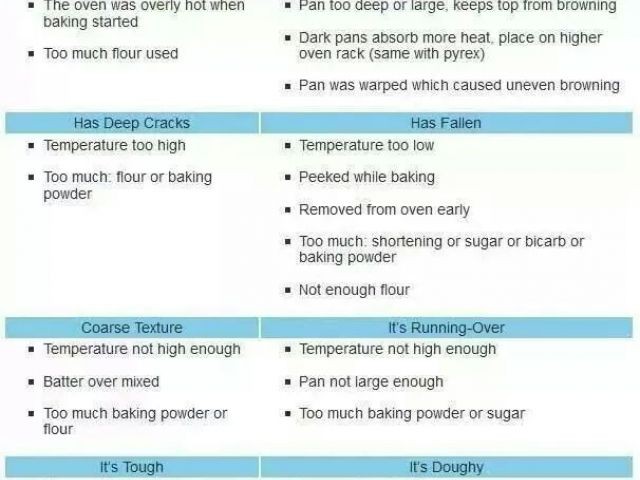
9 favourites
0 comments
5.8K views
INGREDIENTS
Baking cakes can be a fun experience shared by both the baker and those who enjoy eating them. However, there are times your finished product doesn’t turn out the way you planned. Cakes can be very touchy. Make sure you follow the recipe closely and carefully measure all your ingredients. Never make changes in the amounts of ingredients and be careful with substitutions. Make sure you are using the correct pan as called for in the recipe. The wrong pan may change your cake texture or consistency. Make sure your oven is preheated to the temperature the recipe calls for. Oven temperatures frequently vary. You may wish to test the heat of your oven with an oven thermometer.
Below are a few common symptoms of cake failure and what may have caused them:
METHOD
Holes in Cake
• Too little Mixing
• Too little liquid or shortening
• Too cool an oven
Cake Humped or Cracked in Center
• Too hot an oven
• Too much flour
• A combination of the above
Dry Cake
• Too little shortening or sugar
• Too much baking powder
• Overbaked
Sticky
• Too much sugar or shortening
• Underbaked
Cake too brown
• Baked too long
• Oven too hot
• Too much sugar
Not brown enough
• Too big a pan
• Too little baking powder or inactive baking powder
• Not baked enough
• Too little sugar
Cake Falls
• Underbaked
• Substituting self-rising flour and not reducing leavening
• Overmixing
• Jarring cake or opening oven door before cake sets
Crumbly Texture
• Too little mixing
• Too much shortening or sugar
Baking is a fairly precise science. Sometimes when working with a new recipe you may have to adjust your recipe to your kitchen conditions to get that cake to turn out just right. Knowing why your cake didn’t turn out perfect can greatly assist you.
Tracy west






